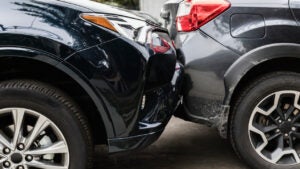What is a lienholder?

If you’ve ever financed a car, you’ve likely dealt with a lienholder, whether you realize it or not. A lienholder is a lender, bank or financial institution that holds a legal claim to your vehicle until you repay your loan in full. If you’re financing your vehicle, your lender also likely has insurance minimum requirements. Bankrate’s team of insurance experts explain what a lienholder is, your ownership rights and how auto insurance is affected.
What is a lienholder?
Lienholders are financial institutions, like banks or credit unions, that loan you money to buy a vehicle. The amount you owe is a lien, which guarantees the lender will receive loan repayments. The lien holder has a financial and legal interest in your vehicle until your loan is paid off.
How does a lienholder work?
When you finance a vehicle, you agree to repay the loan balance and interest in installment payments. The lender is technically a co-owner of the car and has legal claim to it until you pay it off. If you fail to repay the loan or otherwise default, the lender can repossess the vehicle to recoup its losses. Once you pay it in full, the lender releases you from the loan with a lien release, and you become the full legal owner of the vehicle.
Why is there a lienholder on my car insurance?
When a lender finances your car, they want to make sure that the vehicle — its collateral — is fully protected. Lenders typically require full coverage with comprehensive and collision coverage and may limit how high you can set your deductibles.
Because the lienholder has a stake in the car’s value, they’re listed on your car insurance policy to ensure your coverage meets the lender’s requirements and remains in force. The lienholder will also receive a notification if the policy cancels, in which case it can require force-placed insurance on the vehicle to protect its interest and add it to your loan balance.
Who needs a lienholder?
Anyone financing their vehicle rather than purchasing it outright will need a lienholder. The most common type of lienholder is the loan issuer of your car loan. A lienholder is usually a financial institution, but it may also be a person. For example, if your grandparent loans you the money to buy a vehicle and you’re making payments to them, they can be considered a lienholder.
But there are other rare occasions when a lienholder may be added. A person may file a mechanic’s lien on your vehicle if you don’t repay a debt. The mechanic’s lien may need to go through the courts first before a lien can be added at the DMV.
Do I need a lienholder if I lease a car?
A lienholder is only needed when financing a vehicle. A lease is not a loan because you don’t own the car — you’re essentially renting it for a set time. There is a financial transaction going on between you and the company that leases you the car. But instead of being called a lienholder, the entity is referred to as a lessor.
Does a lien affect car insurance?
While a lien doesn’t directly affect your car insurance rates, it does affect your coverage needs, which can determine how much you pay for auto insurance. If you have a lienholder, car insurance requirements may be different from the minimum liability requirements in your state.
Liability coverage meets most state’s requirements, but only protects other vehicles and property you damage in an accident. Full coverage includes comprehensive and collision coverage, which covers damage to your financed vehicle and protects the financial interest of the lienholder by ensuring you can afford to repair the accident damage.
How to find out if a car has a lien
If you’re interested in purchasing a pre-owned vehicle, it’s a good idea to check and see if the car has a lien. An individual may have placed a mechanic’s lien on the vehicle or the car payments were not paid in full, resulting in a possible repossession if the car is located.
Purchasing a vehicle with a lien means you’re ultimately responsible for outstanding debts to the lienholder. Here are some ways to find out if a car has a lien before you buy it:
- The fastest way to check if a car has a lien is by reviewing the vehicle’s documentation. Check the vehicle’s title to see if a lienholder is named on the title. Most states hold the title until the lien is paid off. Only nine states — Kentucky, Maryland, Michigan, Minnesota, Missouri, Montana, New York, Oklahoma and Wyoming — send the vehicle title with the owner’s name and lienholder’s name directly to the vehicle owner to hold until the loan is paid off.
- If you don’t have access to the title, many states have an online title checker. You’ll need to enter the vehicle identification number (VIN) to receive a title report on the car.
- You can pay for a title report from companies that provide car histories and perform VIN checks. The companies provide a title check as well as an accident history for the associated vehicle.
How do I buy a car with a lien?
Many people sell vehicles with a lien. If you know that the car you’re interested in buying has a lien and you’d like to move forward with the purchase, there are some steps you could take to protect yourself before you buy the car:
- Negotiate a lower price for the vehicle. You may be able to deduct the outstanding loan from the vehicle purchase price and use the deduction to pay the loan off.
- Ask the seller to get the vehicle loan discharged. For your protection, wait for the seller to complete the process before you purchase the vehicle.
- Convince the seller to pay off the loan amount. The seller may be willing to pay the loan off with the proceeds from the sale. Be sure to get the agreement in writing and a lien release with the title when finalizing the sale.
- Ask the seller to refinance the amount owed. If the seller can refinance the amount to pay off the lien on the vehicle, it clears any financial responsibility from you when you purchase the car.
How to add or remove a lienholder
The easiest way to add a lienholder to your auto policy is to contact your auto insurer and provide them with your lienholder’s information. The insurance company will need the name and mailing address of the financial institution servicing your loan. You can find this information on your loan agreement or by contacting the lender and asking what the lienholder information for your car insurance policy is. The lender will send documentation to the DMV in your state to be added to the title as the lienholder.
After you pay off your vehicle, you can remove the lienholder from your auto insurance policy. Your insurance company may request proof that the loan has been paid in full, which can be a letter from the lienholder releasing you from the loan or, if you’re in a title-holding state, a copy of the lien release you receive from the DMV. The lender should send the lien release to the DMV automatically once the loan has been repaid, and the DMV will mail you a clear title. Then, it’s up to you if you want to continue carrying comprehensive and collision coverage on your vehicle. Keep in mind that if you remove these coverage types from your policy, you will pay out of pocket for damage your vehicle received in instances like hitting another vehicle or receiving hail damage.
Frequently asked questions
Why we ask for feedback Your feedback helps us improve our content and services. It takes less than a minute to complete.
Your responses are anonymous and will only be used for improving our website.
You may also like

What is property and casualty insurance?

What is car storage insurance?

What is medical payments coverage in car insurance?



